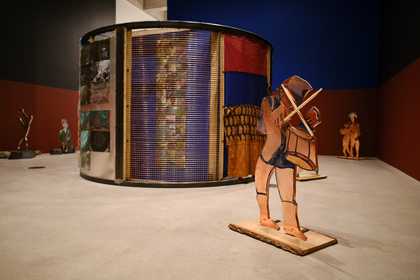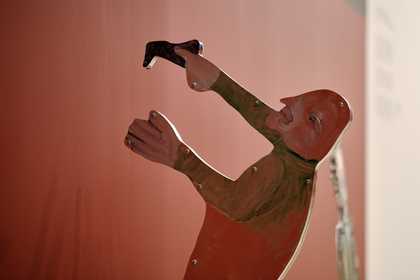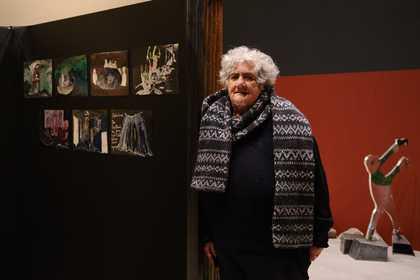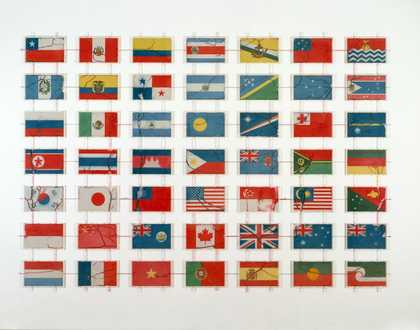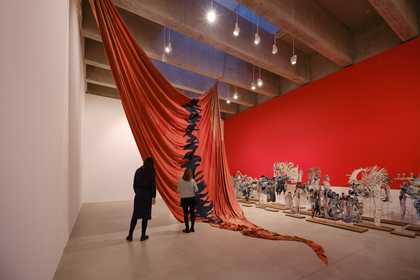
Anna Boghiguian exhibition © Tate. Photo: Ian Kingsnorth
Introduction
This is the first major UK exhibition devoted to Anna Boghiguian (born 1946, Cairo, Egypt). First organised by Castello di Rivoli Museo d’Arte Contemporanea, it brings together notebooks, drawings, paintings, photographs, sculptures and large-scale installations, including a new work made for Tate St Ives.
Books have been central to Boghiguian’s work since the 1980s, from bound volumes and concertina folds to series of single drawings that recall film frames. Equally, Boghiguian’s walk-through installations such as The Salt Traders 2015 and Promenade dans l’inconscient 2016 are like giant pop-up books.
Boghiguian has travelled all her life. The daughter of an Armenian clockmaker, she studied political science and art in Cairo, Egypt in the 1960s and arts and music in Montreal, Canada in the early 1970s. While keeping her studio and home in Cairo, Boghiguian travels extensively, bringing direct knowledge of world cultures and politics into her work.
A close observer of the human condition, Boghiguian proposes a unique and diverse interpretation of contemporary life. She draws equally on the past and the present, poetry and politics, joyfulness and a critique of the modern world.
A Play to Play 2013

Anna Boghiguian A Play to Play 2018. Installation view © Tate. Photo: Ian Kingsnorth
This work is inspired by Dak Ghar (The Post Office), written in 1912 by the Indian poet Rabindranath Tagore (1861–1941). Anna Boghiguian has recreated the characters and settings of Tagore’s play through paintings and cut-out figures inspired by props used in forms of folk theatre.
Tagore’s play tells the story of Amal, a boy confined to his home by a serious illness, who dreams of receiving a letter from a king. Amal’s separation and death are considered to represent India when it was under British rule (1858–1947). To research this work, Boghiguian visited Santiniketan, India, where Tagore founded a school promoting outdoor teaching.
Boghiguian’s work also pays tribute to educator and writer Janusz Korczak (1878–1942). During the Second World War, Korczak staged The Post Office as a play at his orphanage. This children’s home was in the Warsaw Ghetto, where Jewish citizens were imprisoned during the Nazi occupation of Poland. Korczak and the orphans were later transported to the Nazi death camp at Treblinka in 1942.
The Salt Traders 2015
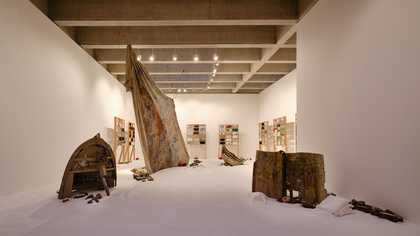
Anna Boghiguian exhibition © Tate. Photo: Ian Kingsnorth
I remember a folk tale in which a king asked his daughter to describe her love for him. And she said: “like salt”. Her father disliked the comparison, but she showed him that everything is tasteless without salt. He realised that for his daughter he was the taste of life, and that the girl was brilliant. I have always been the girl that tastes the salt.
Anna Boghiguian
Made up of painted sails, collages, honeycombs, sections of a boat, red wool and salt, this work is inspired by the commerce and history of salt. It is based on a story imagined by Anna Boghiguian about an ancient Roman salt ship emerging from melting polar ice in the year AD 2300. In Boghiguian’s story, future civilisations use this ship to learn about the history of their world.
In ancient China, Egypt, Rome and elsewhere, salt was a valuable commodity used to preserve food. The Latin salarium (salt money) is the origin of the word ‘salary’. The trade of salt has contributed to the creation of ports and shipping routes that have triggered human migrations to the present day.
The Salt Traders links world events relating to salt across history: the travels of Alexander the Great to salt lakes in Egypt; Mahatma Gandhi’s pacifist Salt March in India; and the recent economic crisis in Greece, which Boghiguian terms ‘a collapse of bread and salt’. She has mapped these histories, as well as scientific formulae related to salt, onto the various elements of her installation.
Promenade dans l'inconscient (A Walk in the Unconscious) 2016

Anna Boghiguian exhibition © Tate. Photo: Ian Kingsnorth
This installation brings together stories, people and symbols from the history of the city of Nîmes, France. It is named after the title of Anna Boghiguian’s exhibition in Nîmes in 2016–17.
Named after Nemausus, a Celtic god once worshipped in the region, Nîmes was founded by Roman military generals returning from the Battle of Actium, Greece (31 BC). This conflict led to Rome’s control of Egypt, which Nîmes’s coat of arms references by showing a crocodile, representing Egypt, chained to a palm tree symbolising Roman victory. More recently, Nîmes has been a centre of the global textile industry and is known for the bullfights that still take place in the city’s Roman arena.
Boghiguian’s procession of cut-out figures is a march backwards through Nîmes’s history, featuring gods, Roman soldiers, a bullfighter and many other characters. The installation also includes Nemausus 2016, a blood-red curtain with a blue form that recalls both the palm tree and crocodile from Nîmes’s coat of arms. This shape is made from denim, a material that originated in the city and takes its name from the French phrase serge de Nîmes (meaning sturdy fabric from Nîmes).
The Studio
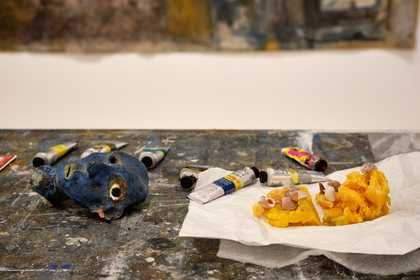
Anna Boghiguian exhibition © Tate. Photo: Ian Kingsnorth
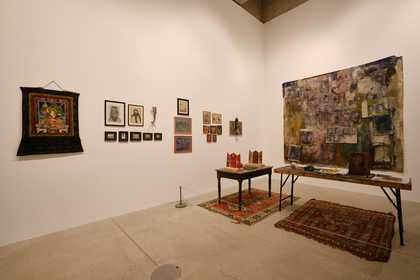
Anna Boghiguian exhibition © Tate. Photo: Ian Kingsnorth
This room is a replica of Anna Boghiguian’s studio in Cairo, Egypt. Alongside brushes, pencils and cans of pigment are objects and artworks that the artist has owned for many years or bought in second-hand shops. There are also pomegranates, one of the symbols of Armenia, referencing Boghiguian’s ancestral heritage.
Accompanying these objects are many of Boghiguian’s own works. Shown on the walls are early paintings, including a portrait of Boghiguian’s mother from 1978 and a self-portrait from 1979, inspired by a painting in the ancient palace at Knossos, Greece.
On the tables are portraits of Buddha in encaustic, a medium that mixes pigment with wax. There is also a work dedicated to Alexandria, Egypt, hometown of the poet Constantine P Cavafy (1863–1933), an important reference in Boghiguian’s work.
A Tin Drum that has Forgotten its own Rhythm 2019
The new work relates to the history of Cornwall. It shows how history has changed and the tin mines have been abandoned. Tin is somehow the backing of the world, as important as steel.
Anna Boghiguian
For this exhibition at Tate St Ives, Anna Boghiguian has created a new work inspired by the industrial history and culture of Cornwall. Made with tin sheets and cut-out figures, the installation refers to local tin mining. Once one of the most active in the world, the Cornish tin mining industry gradually slowed down up to the closure of the last mine, South Crofty, Pool in 1998.
The cut-out figures show different characters from Cornwall’s history, including tin miners and fishermen. These figures are made of steel and electroplated with tin, nickel and copper, materials and processes that have traditionally been used for canning pilchards fished off the Cornish coast.
The central structure is clad with tin and other materials, inspired by homes Boghiguian saw on a recent trip to Ethiopia. In this way, she connects Cornwall’s industrial past with references to the world of today. The structure is painted with figures and scenes inspired by the time Boghiguian spent in West Cornwall leading up to this exhibition.

